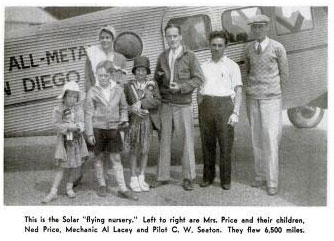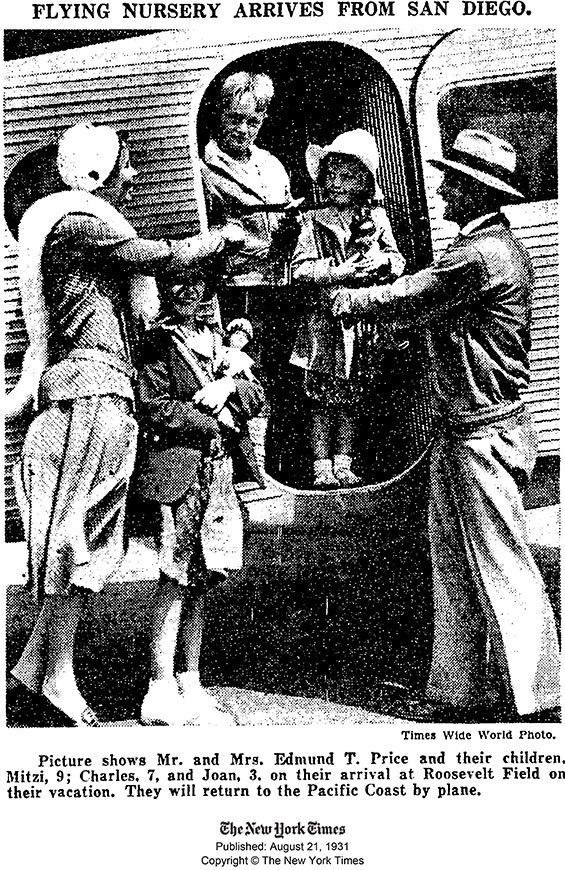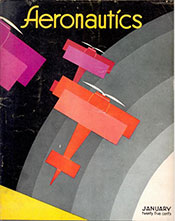|
This aircraft was manufactured in 1930 by the Solar Aircraft Company, San Diego, CA. It was an all-metal biplane (sesqui-plane) with a 420HP Pratt & Whitney Wasp engine. It carried eight passengers, with a range of about 500 miles. It was a large craft with a wing span of 56.5 feet and a length of almost 36 feet. Its first flight was in January, 1930.
Only one aircraft, NX258V, was manufactured by the company. Soon after it was manufactured, the Great Depression caused orders to dwindle and disappear. The Solar Aircraft Company abandoned aircraft manufacture, but leveraged its metal working skills toward the manufacture of other metal consumer products, and thus survived the Depression.
Solar Owner Ned Price, Center, Popular Aviation, November, 1939 (Source: PA)
 |
NX258V landed at Tucson, Wednesday, September 16, 1931 at 12:05PM. The pilot was C.W. Seaton (in the photo at left), who carried six passengers unidentified in the Register (they are the people in the photograph, see below). They were northwestbound from Lordsburg, NM, through Tucson, to Phoenix, AZ.
The New York Times, August 21, 1931 (Source: NYT)
 |
Because of articles that appeared in The New York Times (NYT), August 21, 1931, and in Popular Aviation (PA) magazine, November, 1939, we have photographs of Seaton, and we know who his passengers were.
From Popular Aviation, the article, "Pots and Pans But No Airplanes," is available at the link (PDF 2.0Mb). You'll find the photograph above in that article, which identifies the six people in the airplane with Seaton at Tucson. Seaton is on the far right. The owner and manufacturer of the airplane, Edmund "Ned" Price, wears a jacket at center.
From both articles, we also know the context of their Tucson visit. It was part of a transcontinental flight. Price needed to be in Massachusetts to tend to his father's estate after his death. But, along the way, the entourage used the flights to demonstrate the airplane and let prospective buyers see what was probably their first all-metal airplane. No orders emerged.
In case you're wondering, the reason for the eight year gap in reportage is that the Times article was a contemporary report of the flight as it passed through New York City. The Popular Aviation article reported on the Solar Aircraft Company business as of 1939, and cited the earlier transcontinental flight as background. The Times article, right, was headed by the photograph of the Price Family, below.
From The New York Times, the news photograph of the Price family at Roosevelt Field, Long Island in August, 1931.
Price Family in New York With NX258V (Source: NYT)
 |
Popular Aviation described their eastbound trip as follows. Mr. Price is being quoted:
"In August, 1931, I had to fly back to my home in New Bedford, Massachusetts and decided to take my family with me. I loaded Mrs. Price, Mitzi, aged 9; Charles, 7; and Joan, 3, into the plane and under the piloting of capable Bill Seaton, well-known western flyer, headed eastward. The newspaper men got wind of the flight and the Solar MS-1 became the 'Flying Nursery.' At every airport the press met us. We were written up all over the nation. The 'Flying Nursery,' a ship so safe that the manufacturer made a transcontinental trip with his entire family, became a by-word of the time. We even had poems written about us and kindergarten magazines took up the story...." |
Alluding to company finances, the magazine described their westbound flight as follows. It was during their westbound leg that we find them signed in the Davis-Monthan Register. They were away from San Diego over a month:
| "The 'Flying Nursery' landed at San Diego with hundreds of publicity clippings, a family that had flown 7,000 miles, covered 25 states and 50 airports; landed at home port with an empty order book to find the ledger showed total debts were five times total assets...." |
The transcontinental voyage was a grand and singular trip for NX258V, and probably a cornerstone of adventure and memory for the Price children. Regarding the fate of the airplane, Mr. Price is quoted again:
"We finally sold the MS-1 to a Mexican rancher for use in tranporting coffee from Tabasco to the coast, decided to sidetrack the manufacture of planes.... So it was then we commenced making frying pans, baking utensils, book ends and beer barrels, even if our thoughts sometimes wandered to a metal plane loaded with coffee, flying over the countryside in Mexico." |
The sole Solar was destroyed in an accident in Mexico in 1936. NX258V also landed once and is signed in the Register of Clover Field, Santa Monica, CA. Please follow the link to view a photograph of the airplane.
---o0o---
THIS PAGE UPLOADED: 07/08/14 REVISED:
|




